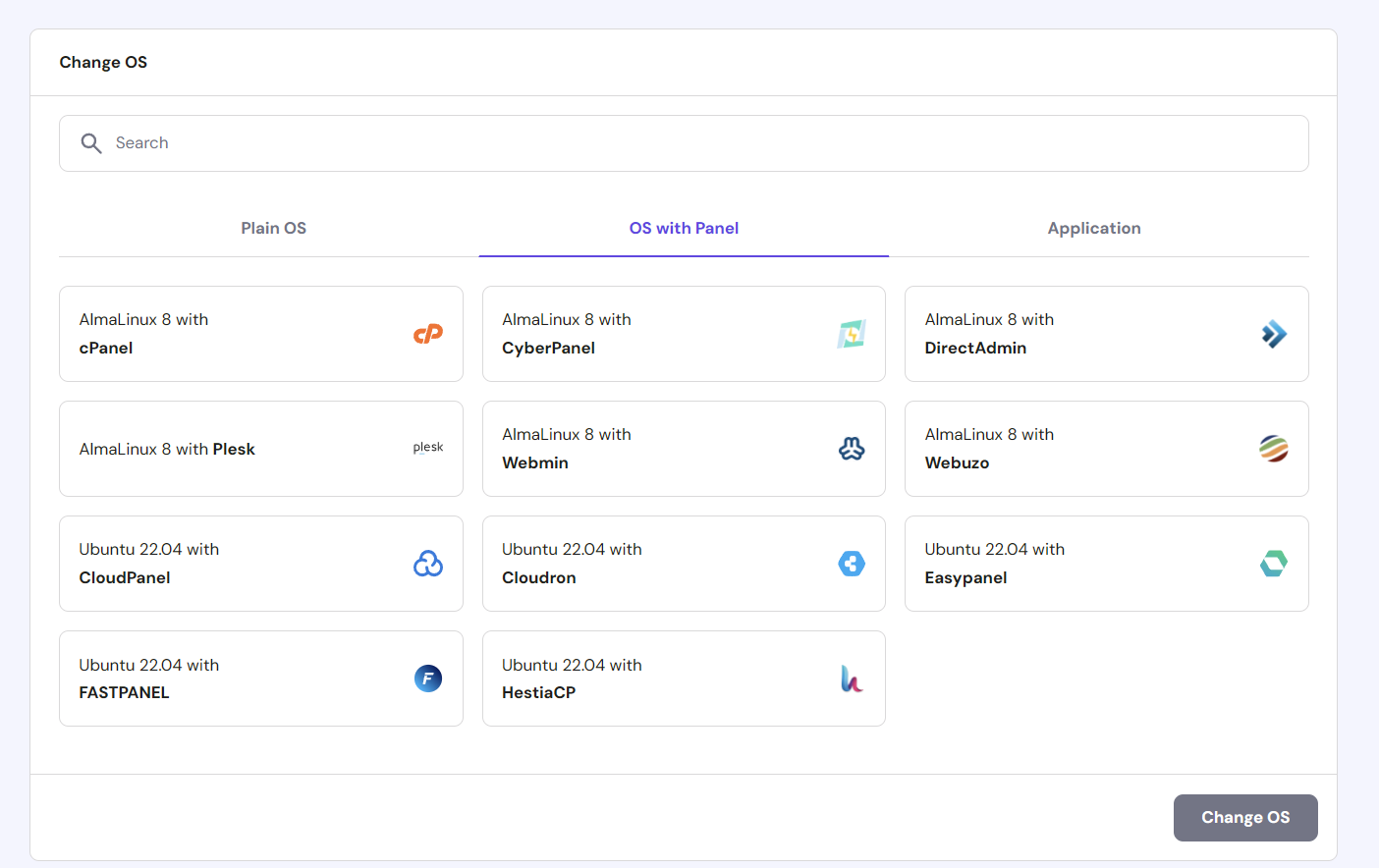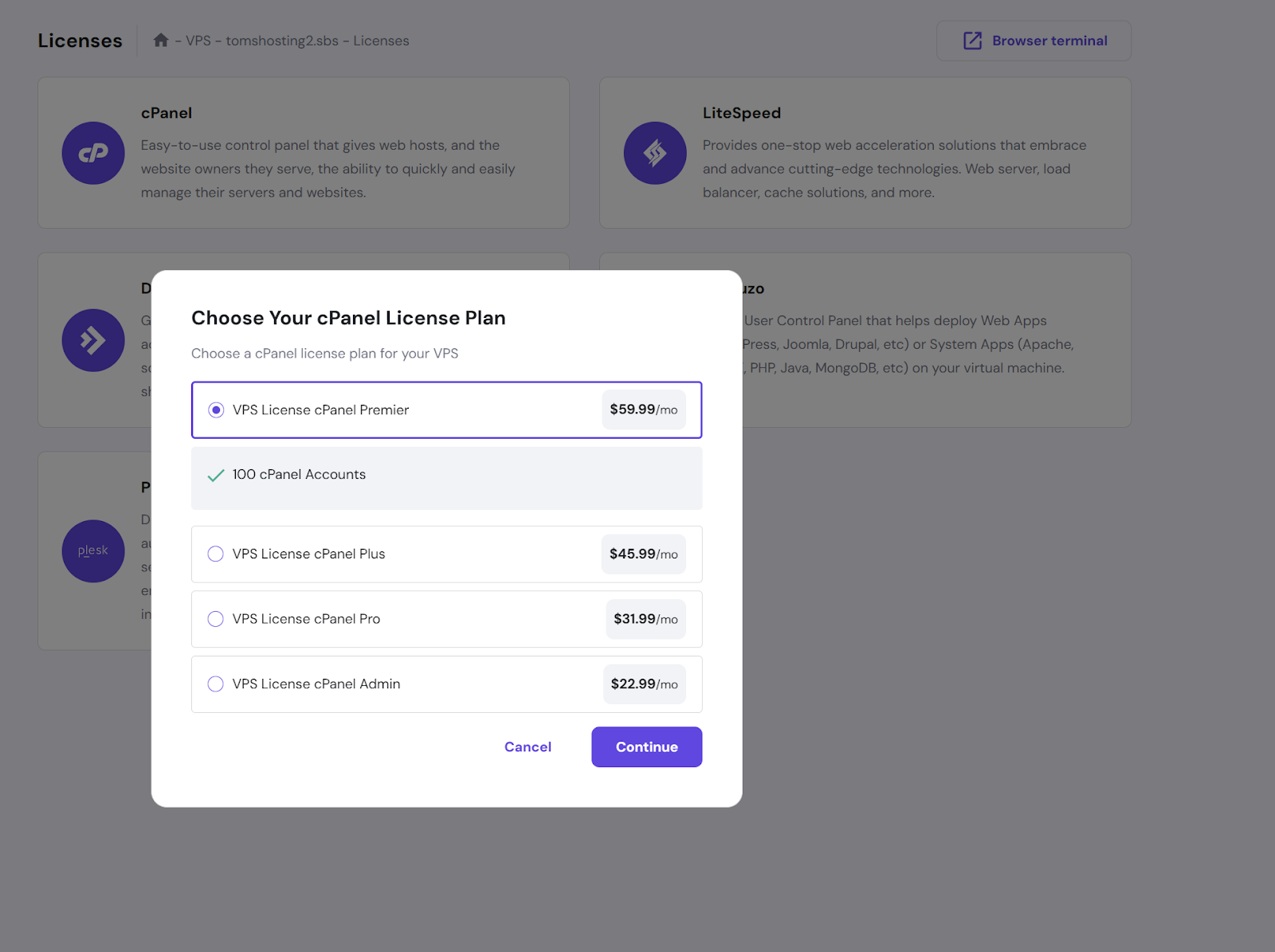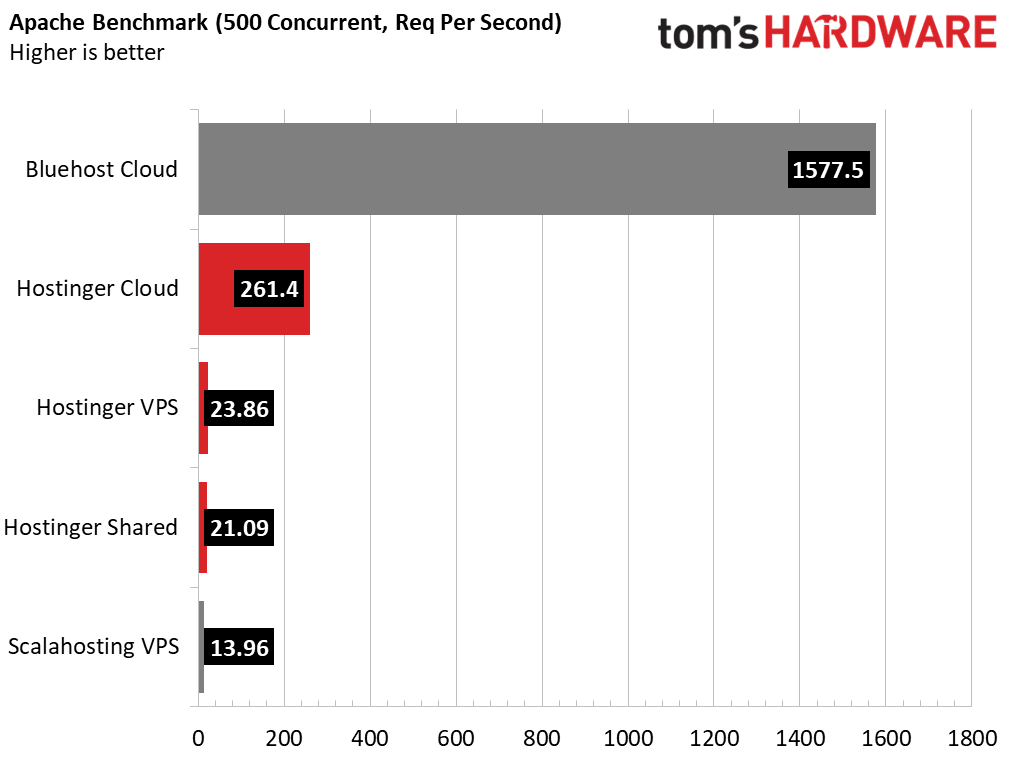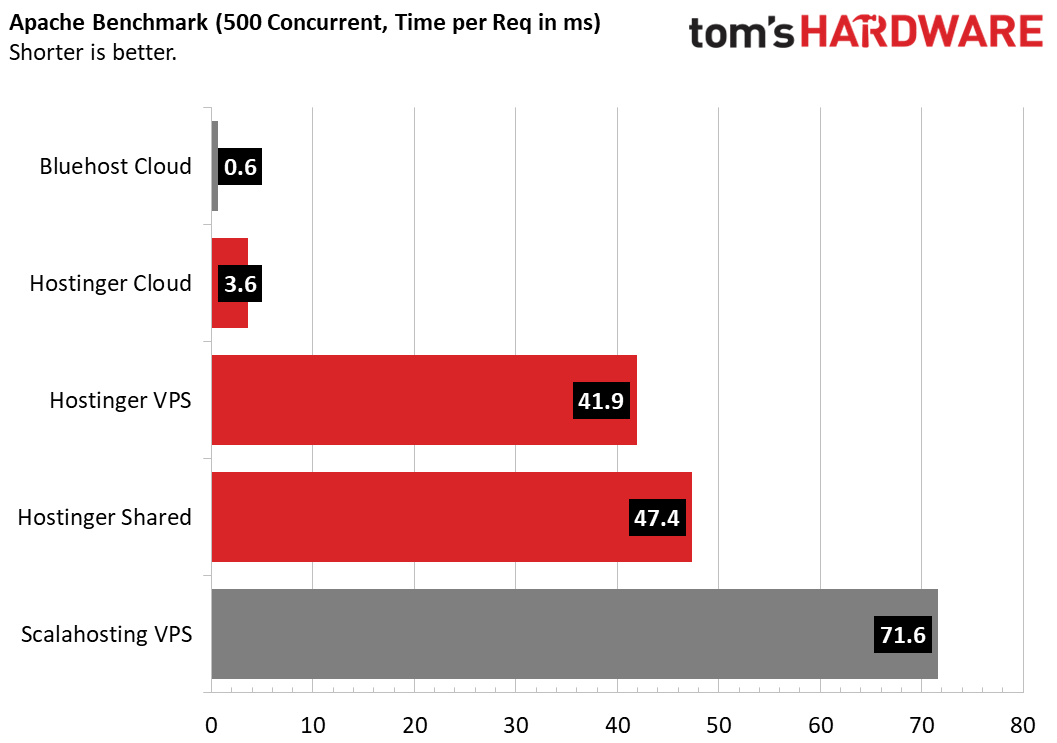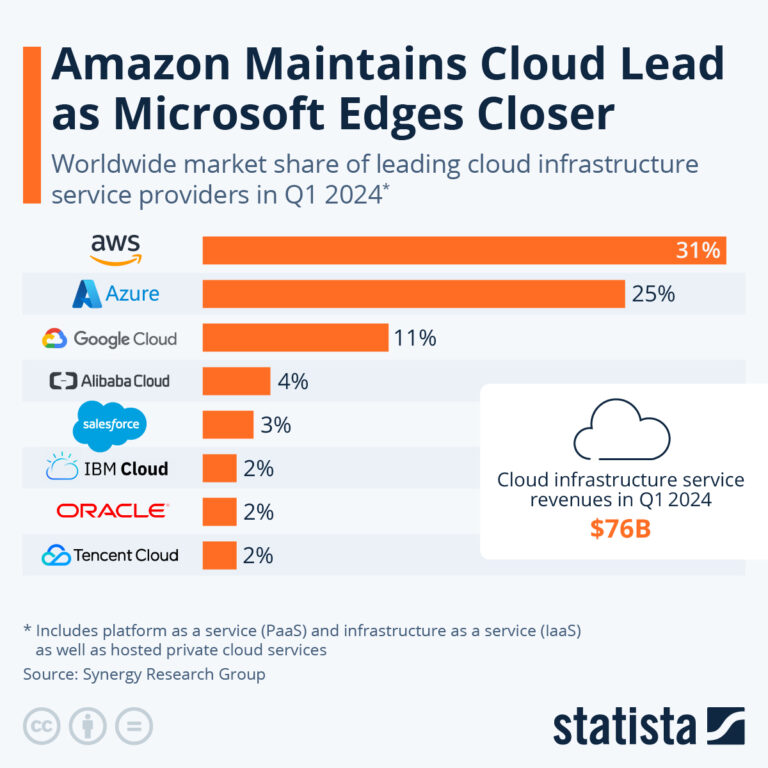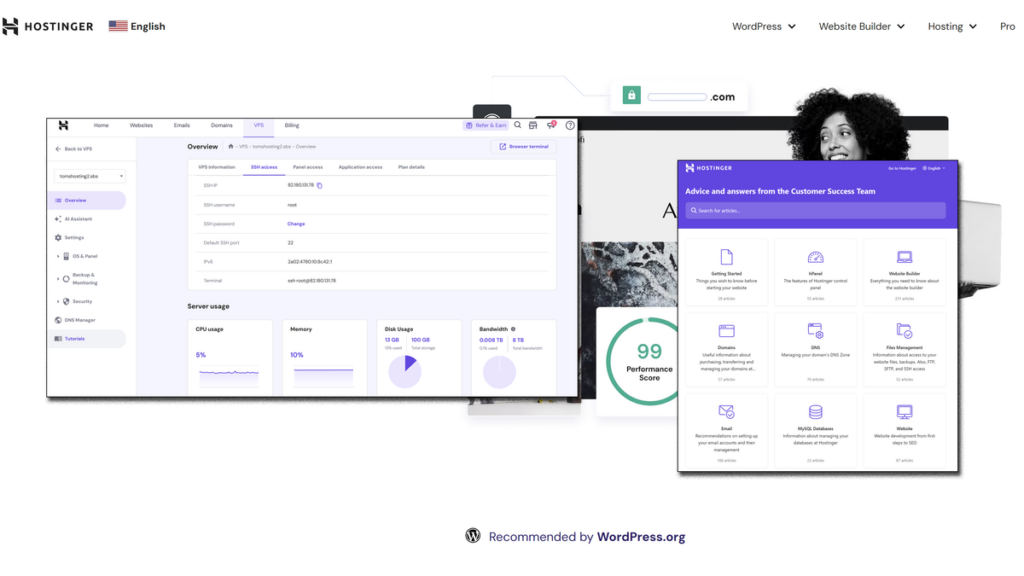
One of the larger and more popular web hosting services, Hostinger was founded in 2004 in Lithuania where it started out offering a free service called 000webhost, which still exists today. The company offers a wide variety of hosting packages, including shared hosting, Virtual Private Servers (VPS), cloud hosting and managed WordPress plans.
Hostinger is also one of the most affordable web hosting services around, provided that you’re willing to commit to 12 or 24 months in advance. But there are also some gotchas: the VPS Hosting, our preferred option for most services, starts at a mere $4.99 a month, but you’ll need to pay at least $23 per month if you want to use the popular cPanel control panel software (other control panels are cheaper or free). Also, the cloud and shared hosting plans severely limit how much database storage you have, making them a poor choice for anyone working with large mySQL DBs.
We had a chance to test three different Hostinger Plans: a VPS plan, a shared hosting plan, and a cloud hosting plan. Overall, we found the performance strong, with good DB query and WordPress benchmark numbers on both the VPS and cloud plans. The cloud plan also did an extraordinary job of handling traffic spikes, though its database storage and script execution limits are downsides.
Hostinger VPS Plan
On Hostinger, as with most hosting services, the VPS plan provides the best balance between performance, flexibility and price. Hostinger has some of the cheapest VPS plans on the market, with the base KVM 1 plan (1 vCPU core, 4GB of RAM, 50GB storage) going for just $4.99 a month with a 24-month commitment (after that, the price goes up to $7.99 a month).
We tested the KVM 2 plan, which provides 2 vCPU cores, 8GB of RAM, 100GB of disk space and 8TB of bandwidth for $6.99 a month, but if you have greater needs, you can get a plan with up to 8 vCPU cores, 32GB of RAM and 400GB of disk space for just $19.99 a month.
That said, there’s a huge catch to these prices that Hostinger doesn’t make clear until you’ve already paid for and signed up for your plan. cPanel / WHM, the most popular and easy-to-use control panel software, is not included, even though many other companies include it.
When you first set up your VPS server (or if you choose to reformat it later), you’re given a choice of OS and control panel to format with. You can go with AlmaLinux 8 or 9, Ubuntu, Debian, or other Linux flavors. And you can have the system install cPanel, cloudPanel, Cyberpanel, Webuzo, or any of several other control panels. However, most of these – including cPanel – require a monthly licensing fee on top of your hosting plan, and it can be extremely costly, with cPanel’s single-user license going for $22.99 a month, more than three times the cost of our hosting plan.
But, if you’re willing to deal with a less-intuitive control panel, you can do what we did: choose AlmaLinux 8 with Webmin / Virtualmin. Webmin is a control panel software that has absolutely no licensing fee and, if you dig into its somewhat annoying menu structure, you can perform all the basic tasks from setting up user accounts to installing vital software such as phpMyAdmin, updating the system files or setting up cron jobs.
You navigate to Webmin by adding :10000 to the end of your URL and then logging in. Once loaded, the control panel is divided into two tabs: Webmin and Virtualmin, each of which has its own set of apps for doing things like managing disk quotas or logging into the file system. Virtualmin seems more like the cPanel (user side) and Webmin seems more like WHM (administrator side), but it’s not always clear which tab you need to find the function you’re looking for.
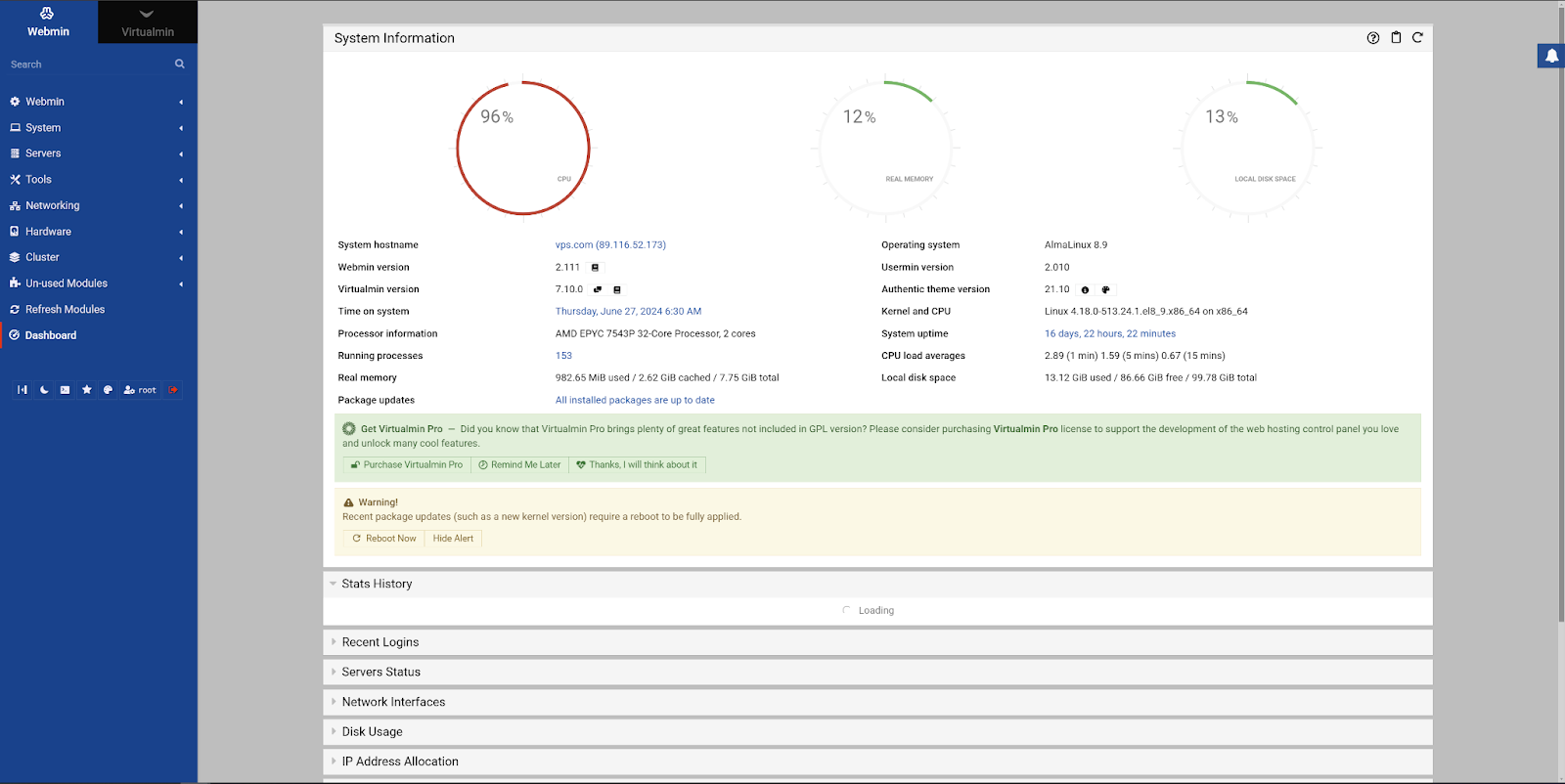
We found the documentation about Virtualmin on Hostinger’s own site lacking and had to Google some issues. For example, my default user account had a disk quota that limited my ability to upload files and I had to do a lot of searching on Virtualmin’s forums (not Hostinger) to find out how to change it. However, once we figured out how to perform the basic tasks, we were glad to have avoided paying $23 a month extra for a version of the same thing – even if cPanel is much nicer.
One thing we didn’t figure out how to do via Webmin was updating the version of PHP that came with the VPS plan, as it was PHP 7.2 when the world is now up to 8.3. And, for some reason, we had trouble configuring the system to use WWW as the default web address, with it instead removing the WWW when we’d go to our sample site. We’re sure if we spent a few more hours experimenting we could have resolved both issues, but it should have been easier and probably would have been with cPanel.
Once we had our server set up, we were impressed with the level of performance and flexibility the VPS plan provides. Connecting via SSH is easy, particularly because an encryption key is not required. Once we had logged into the terminal, we were able to run our sample bash scripts and, even after hours of execution, they never timed out; many hosting plans impose a one-hour (or slightly longer) limit before shutting your scripts down.
Performance on our DB selection and insertion tests was among the strongest we’ve seen (more on that in the performance section below), with the giant database import taking several minutes less than the VPSes we tested from Bluehost and Scala Hosting. The WordPress Benchmark score was strong, but perhaps because of the outdated version of PHP, trailed some other plans, including Hostinger’s own cloud and shared hosting. The VPS plan also managed to hold its own on the Apache server capacity test, where we hit it with 500 concurrent requests, but it didn’t have the most bandwidth we’ve seen.
Hostinger Cloud Hosting Plan
If you want speedy serving and high capacity and are willing to pay for it, Hostinger’s cloud Hosting plans might be your best bet. Cloud hosting, like VPS, uses shared virtual resources, but it spreads the load across multiple physical servers to get you more bandwidth and processing power for the money. You do give up some control, though.
Available starting at rates of $7.99, the cloud hosting plans promise more storage, more bandwidth, and more RAM and CPU cores for your money than VPS. But there’s a huge catch that’s not visible on the sign up page: Even if you get the cloud Professional Plan with 250GB of storage and 4 CPU cores like we did, you are limited to just 6GB of database storage.
What does 6GB get you? If you’re running a WordPress site, that might be a decent amount as you’re just storing the text from your blog posts in the database so you’d need a lot of articles to fill it up. And remember, images in your blog post are not part of the database so wouldn’t count against that cap. If, like me, you run a site that stores a ton of actual data you wish to analyze – this is an untenable limit.
Unlike with VPS, where you have to choose a control panel software such as cPanel, which costs at least $23 a month (or Virtualmin which is free), Hostinger’s cloud Hosting relies on the company’s own hPanel software for all of its controls. For VPS, hPanel is on the top level, but you still need to dig into the server control panels – in our case, Virtualmin – to get major things done like setting up databases or installing software.
But for cloud hosting, hPanel is a very helpful one-stop shop that allows you to create a database, install WordPress (it links directly to your WordPress Admin login), access the file system, enable SSH access, configure PHP, and manage subdomains.
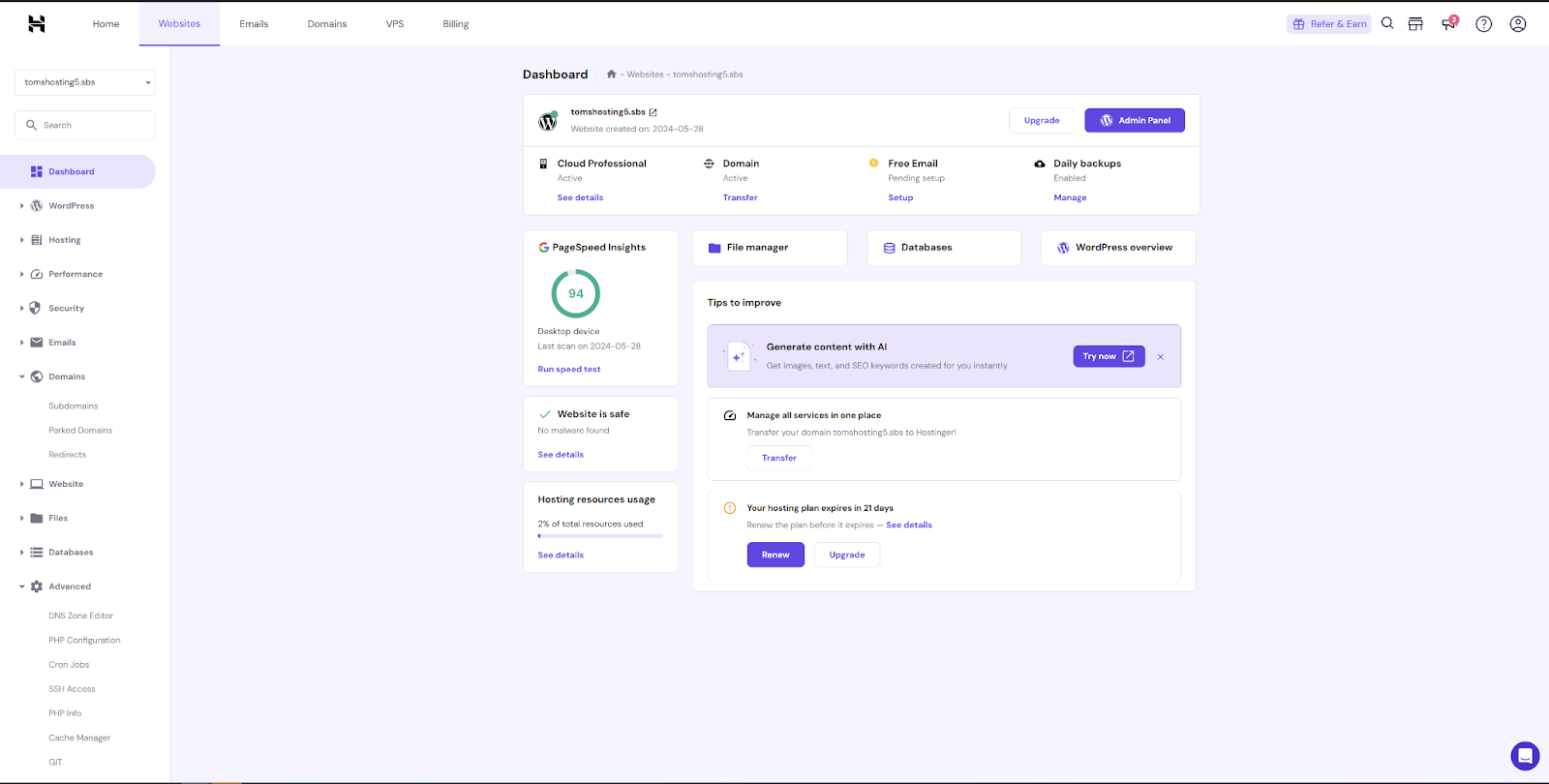
Having every setting and WordPress just a click away in the hPanel is a really nice touch, making this one of the easiest hosting plans to set up and manage. It is a joy to work with.
The performance of Hostinger’s cloud hosting is also a joy, the best we’ve tested so far. It scored 8.6 on the WordPress Benchmark, the highest mark of any service. It also aced our database import test, inserting 87 million rows of data in an average of 5 minutes and 29 seconds, and it delivered a blazing 261.4 requests per second on our Apache test where most other services were in 13 to 25 range. More on those numbers later.
The trade-off of the cloud hosting plan is that it’s not for people handling large amounts of data or running long-lasting scripts. In the case of the latter, we ran our shell script test, which writes a log every minute to see if it’s still alive and, after an hour, it died. If you were doing a massive operation on your database that lasted for longer than an hour – not likely if you are just using WordPress – it would stop in the middle.
Hostinger Shared Hosting Plan
Shared hosting is always the most affordable option at any hosting provider, but usually the least flexible and always the least performant. You can get a shared plan at Hostinger for as little as $2.99 a month, but we stepped up to the $3.99-per-month “Business” plan which boasts 200GB of storage and support for up to 100,000 visits monthly.
As with the cloud Hosting plan, the shared plans use Hostinger’s proprietary hPanel to control everything from your email accounts to subdomains, WordPress install, databases, and even SSH access. The interface is easy-to-use, as all of the options appear in a menu on the left side of the screen and you can open up one of the headers (ex: WordPress) by clicking on it.
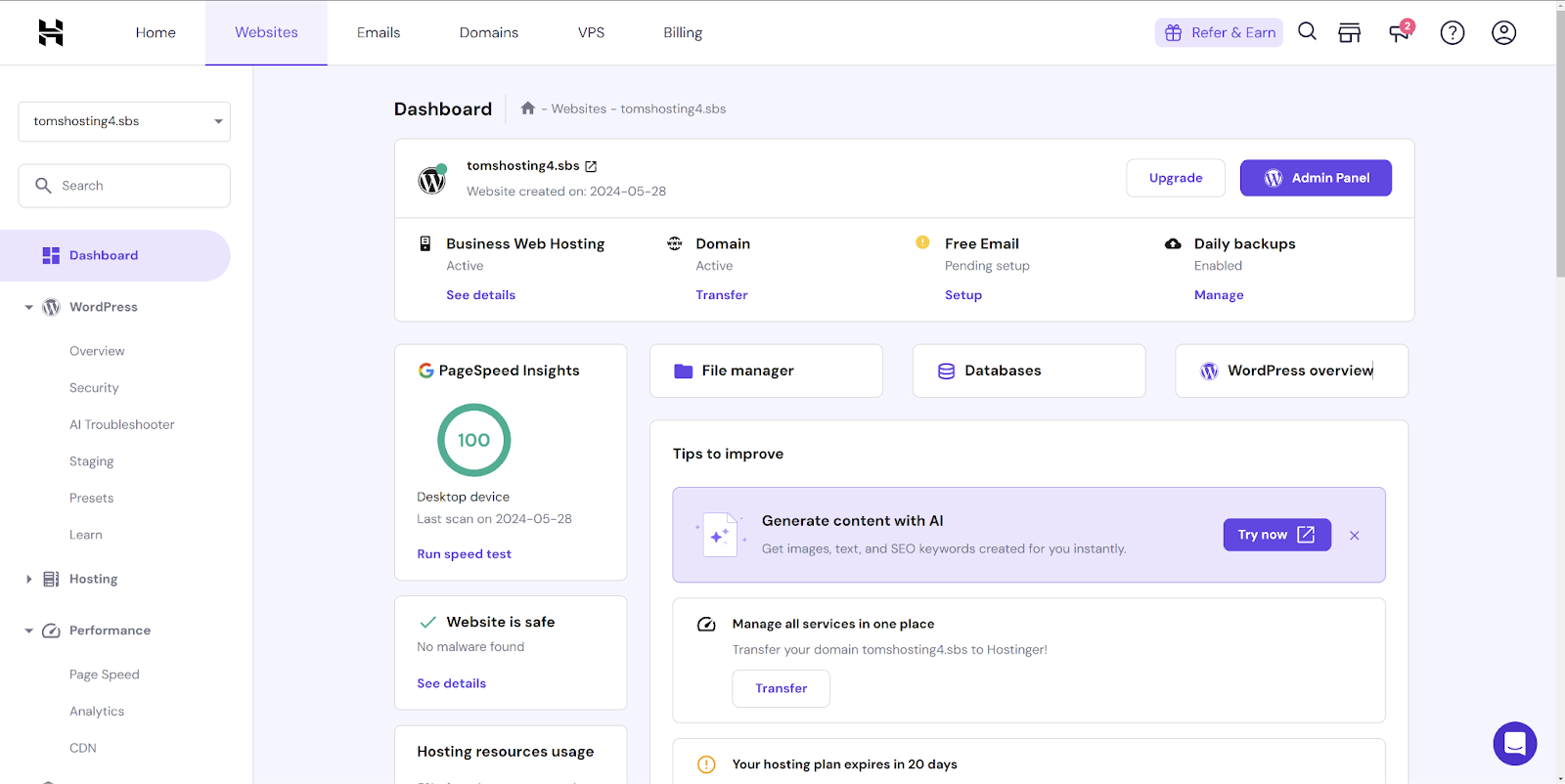
If you want to go into your WordPress Admin panel, there’s also a button for it here. So setting up a WordPress site is quick and easy.
So what do and don’t you get for $3.99 a month? There’s a database limit of 3GB, so it was impossible for us to run any of our database performance tests, which require about 5GB, on this account. Shell scripts also time out after just an hour.
On the bright side, performance on the WordPress Benchmark was very strong, hitting 8.5, one of our higher scores. It also managed to deliver 21.1 requests per second on the Apache test, which is about on par with Hostinger’s VPS plan and other shared hosting plans we tested.
Database, WordPress and Scripting Performance
For every hosting plan, we conduct three database performance tests, designed to see how quickly the server can handle complex MySQL queries. Like many hosting services, Hostinger uses MariaDB, a drop-in replacement for Oracle MySQL, which is supposed to be faster and more cost-effective.
Our first MySQL workload inserts 87 million rows of data, which is drawn from historical page view data for our site, across millions of dates and pages. This is a huge data dump and you can see that Hostinger’s cloud service leads the pack with its VPS service not far behind. Its shared hosting couldn’t perform the test because of a database size limit of 3GB.
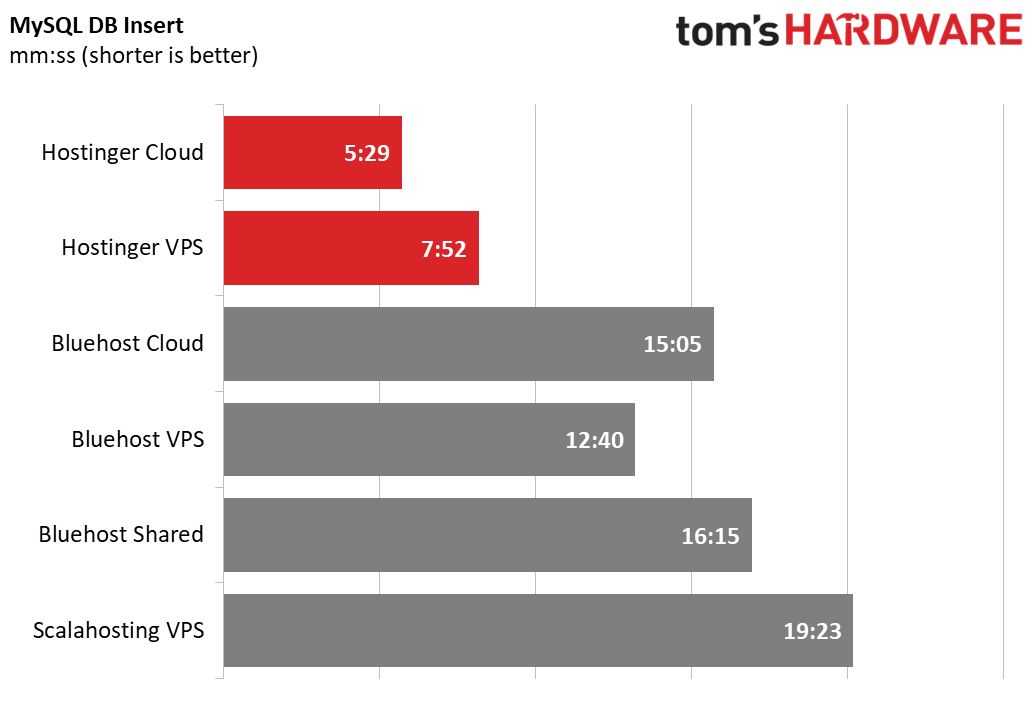
Then we run a MySQL command that changes the six traffic columns in all 87 million traffic rows into random numbers. This process can take longer than the original insert.
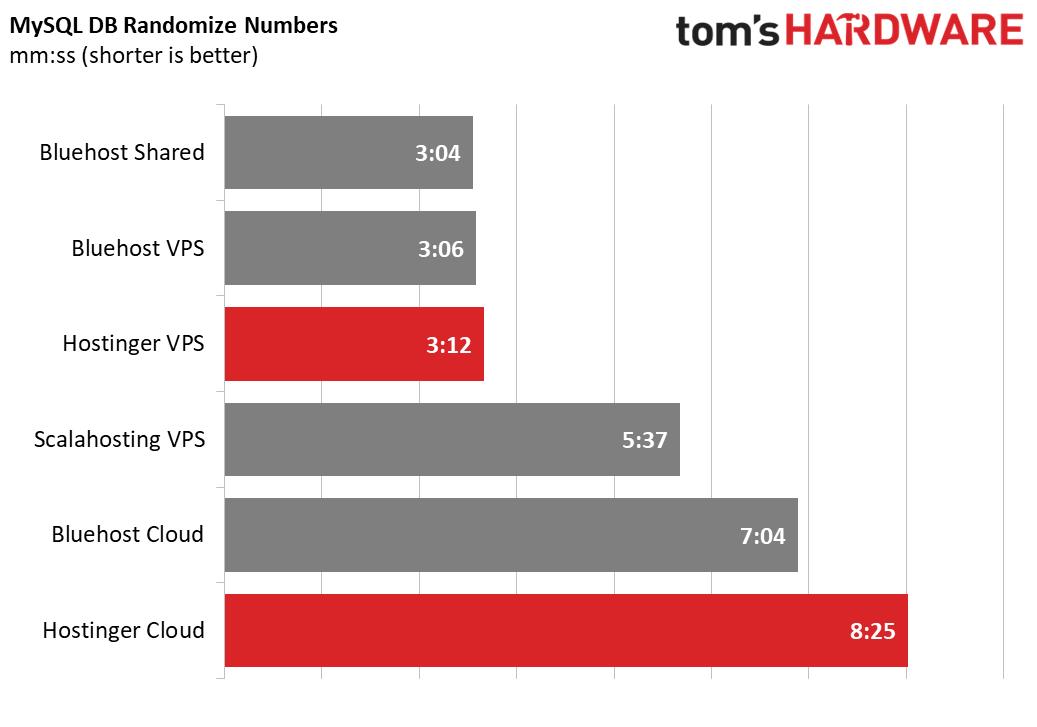
In our most demanding MySQL database test, we join two tables, the traffic table and the articles table, and then instruct the server to return the sum total of all page views, entrances and other traffic numbers across multiple dates per article. This test involves a table JOIN and a huge number of uses of the SUM function, so it’s very time-consuming.
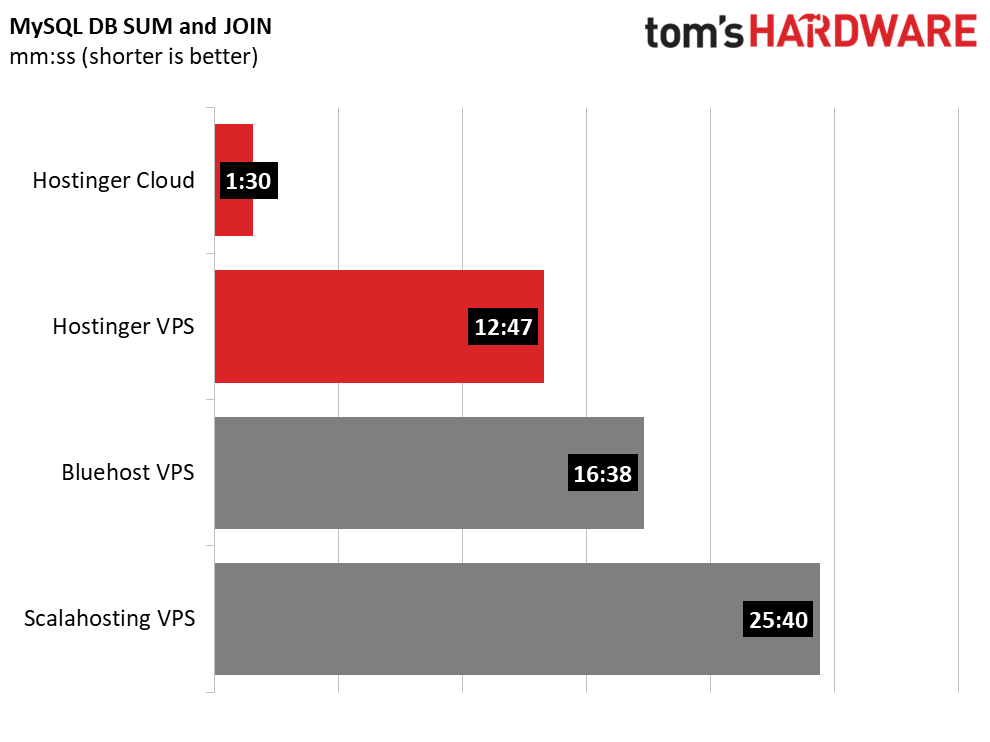
Surprisingly, Hostinger Cloud was almost unbelievably fast to complete this task, finishing it one minute and 30 seconds. We ran the test three times and this is the average, which shows just how quick this plan can be. It’s very odd because, on the randomization test, it did poorly.
The Hostinger VPS plan had a strong, but down-to-earth time of 12 minutes and 47 seconds while Bluehost’s VPS plan took 16:38. Scalahosting VPS trailed the pack by a wide margin, but it actually completed the test. Bluehost’s cloud and shared hosting plans both timed out and refused to complete this task at all.
We also run the WordPress Hosting Benchmark Tool, a test that runs as a plugin within the popular CMS and spits out a score in the 0 to 10 range with 10 being the best. It evaluates the server based on 12 criteria, including filesystem speed, database speed, network performance, and mathematical calculations.
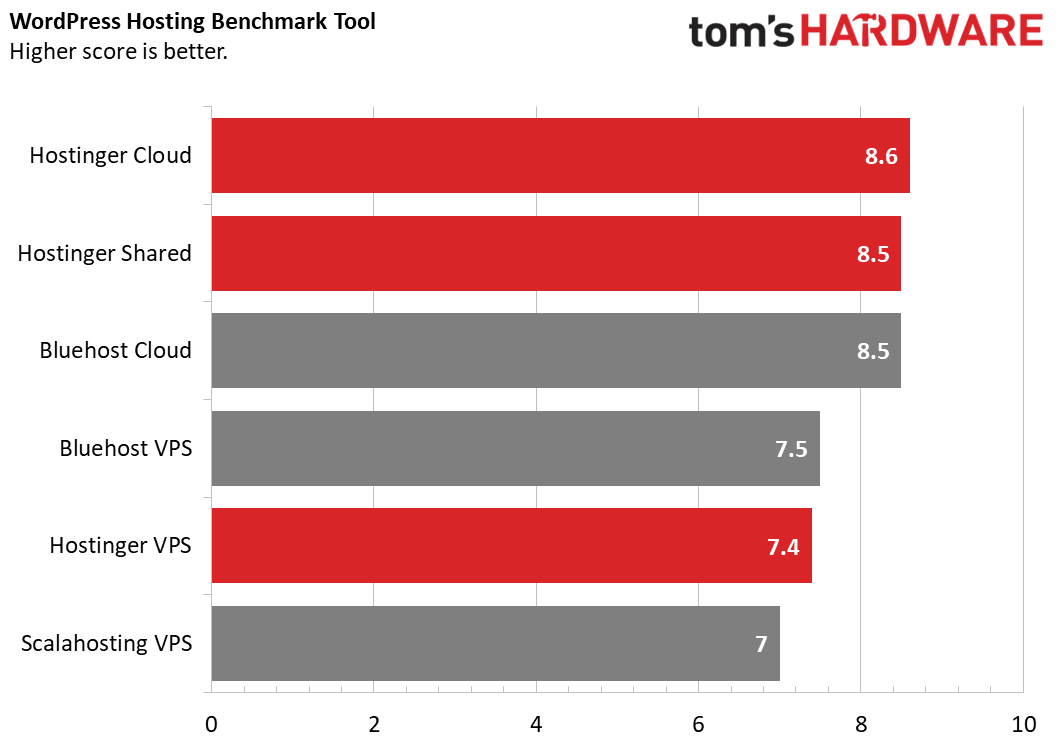
Here Hostinger’s cloud and shared plans happened to outpace its VPS plan, perhaps because the VPS was running a slightly older version of PHP. Bluehost cloud plan also did really well on this test.
Of course, if you’re running big database queries or other time-consuming tasks such as crawling a series of web pages or JSON feeds, you might want to run a shell script that could go for hours. Many hosting plans limit the amount of time a shell script can run before the operating system forces them to stop. To find out what happens, we run a script that writes a log file every minute and we then come back and check on it after several hours.
Both the Hostinger cloud and shared plans terminated the script after an hour. However, the VPS hosting plan had no timeout at all.
Hostinger Traffic and Uptime
If you’re running your website for the purpose of attracting a lot of visitors – and not everyone is – its ability to handle many requests at once matters. That’s why we use the Apache benchmark, which allows us to throw 500 concurrent requests at the server at the same time and then see how it performs. Each hosting service is running a WordPress site and we are pointing the Apache benchmark at its home page.
After running the test, we get a report showing the amount of requests per second that the server was able to deliver and how many milliseconds each response takes on average. This is not the load time of the home page, but the time it takes for the server to respond.
Many of the hosting services simply could not handle the test as they would fail after 149 requests or fewer. This might be a form of protection the services have against spam traffic, or it could be that they simply can’t take that much traffic at once. While all three of Hostinger’s services completed the test, Bluehost Shared failed after a 149 request limit and Bluehost VPS returned a “failed ssl handshake” error.
As we saw elsewhere, cloud hosting allows your server to respond to traffic most quickly. Bluehost cloud returned 1,577.5 requests per second and took an average of just 0.6 ms to respond to a request. Hostinger’s cloud service was also really strong with 261.4 requests per second and a 3.6 ms response time. Consider that the VPS and shared hosting services were in the low 20s of requests per second and about 40ms per response.
Most hosting services offer really good uptime that’s well over 99 percent, but just to keep an eye on things, we use Pingdom to monitor our sample sites for at least a few days. Across several weeks, we saw absolutely no downtime on any of our Hostinger plans.
Pingdom also tracks median load times for our sites’ home pages and, with these three we saw median load times of 727 and 722 ms on the cloud and VPS plans and, strangely, a slightly-faster 447 ms on the shared plan. Scala VPS was 746 ms, so that seems to be reasonable for the default WordPress content we were serving.
Hostinger Support
When it comes to support, Hostinger tries to steer you toward its knowledge base of tutorials, which covers a lot of topics, but has very little information on Webmin / Virtualmin. There was an article on getting started with Virtualmin and one on setting up SSL, but considering how much you have to do through this control panel software, I had to do some Googling to find what I was looking for.
If you can’t find what you’re looking for in the knowledge base, you can eventually (after you’ve opened an article) find a link to launch a live chat with a human.
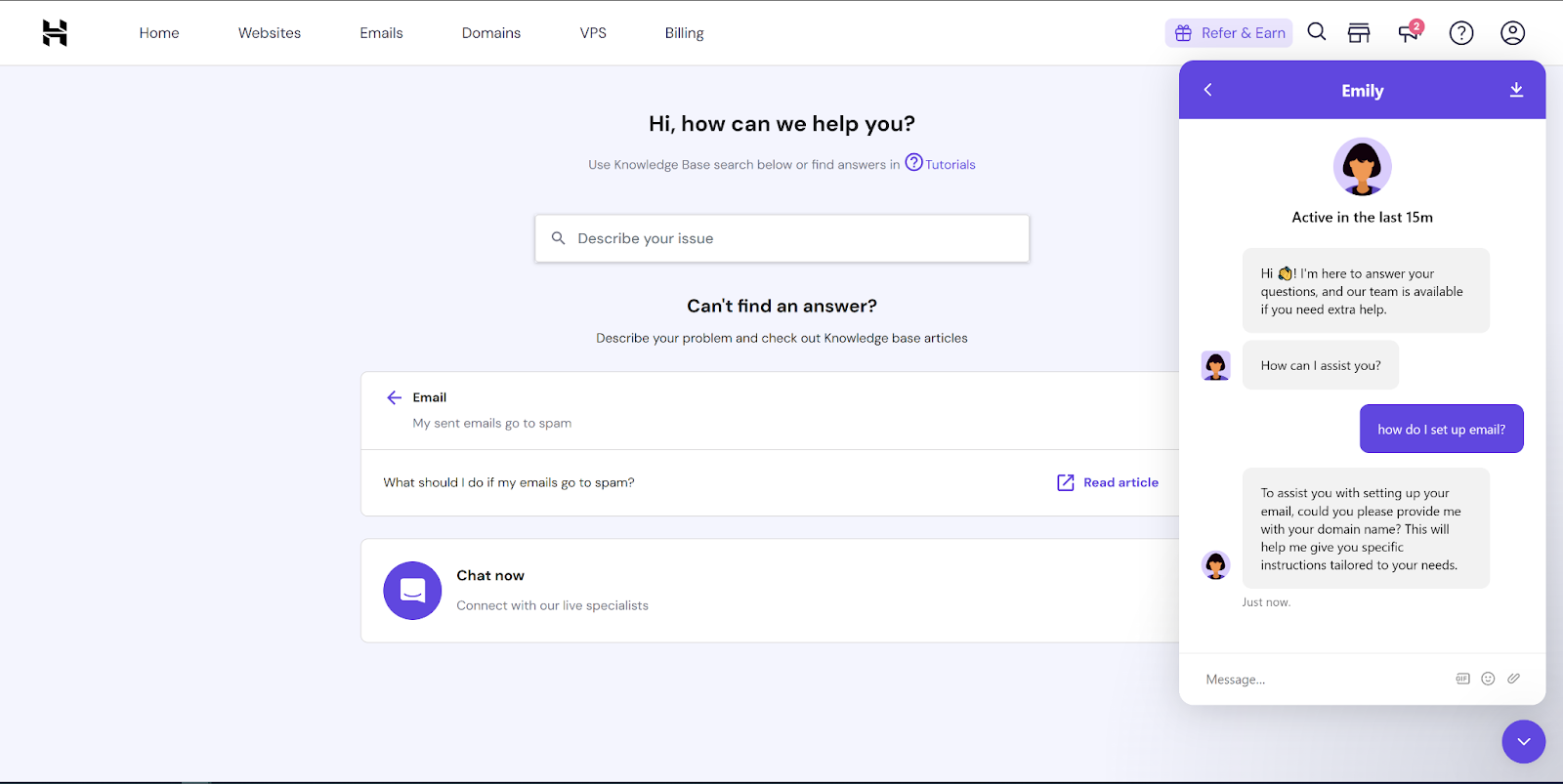
I really wish there was a ticketing option instead, which is something a few competitors like Scalahosting have. That way, if you’re having an issue and you don’t need an immediate resolution, you don’t have to have a long back and forth with a person. You can just make a request and wait to get an email back. As far as I can tell there is also no phone support, but most hosting services don’t have that.
An AI assistant is also on offer via the Hostinger website. This can be used to get quick answers, and requesting “I would like to speak to someone” prompts a series of questions to connect you with an appropriate specialist.
Bottom Line
Across its major services – shared, cloud and VPS – Hostinger offers great value and strong performance. But beware database size limitations on the cloud and shared plans and the exorbitant cost of adding cPanel software to your VPS plan, an option you can avoid by using the poorly documented and sometimes confusing Webmin / Virtualmin panel instead.
If you’re running a WordPress content site and want to accommodate the most traffic at the highest speed, a cloud plan is your best choice. If you just want a plan that’s cheap but reliable for hosting a personal or very small business site with few visitors, the shared plans can fit that bill.
However, Hostinger’s VPS plans offers the most flexibility and value for your money. For $4.99 to $19.99 a month, depending on the amount of RAM, CPU cores and storage space, you get the ability to work with large databases, install your own software, and choose among various Linux OSes and control panel applications.
While the overall performance of VPS is not equal to that of cloud, it’s still better than most VPS plans we tested, and the added level of control makes it a better choice for professional website builders who don’t want to encounter any limits. Just make sure you’re either willing to learn to use Virtualmin, or budget in another $23 a month to your cost so you can have cPanel.
